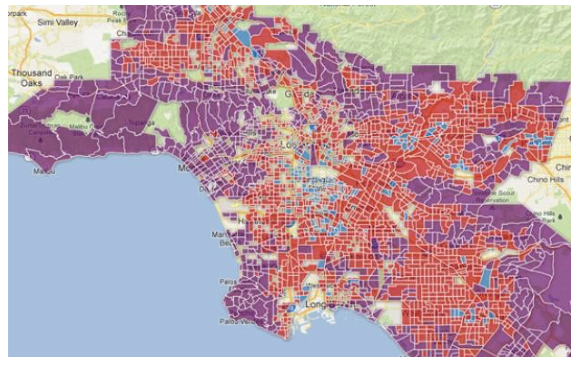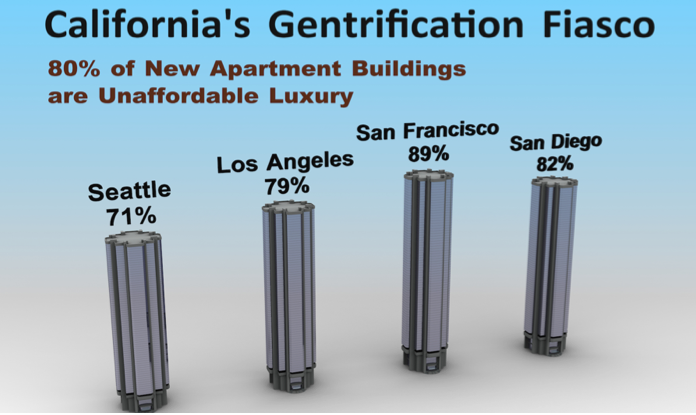CommentsPLANNING WATCH-To much of the public “Department of City Planning” brings up images of widespread gentrification, a former Director of Planning paying a $281,000 fine for lobbying his former colleagues on behalf of real estate developers, and hundreds of eyes averted from FBI investigations and indictments of their bosses accepting bribes to approve major projects.
But, despite this dirty linen, in a soaring statement LA’s Department of City Planning publicly staked out its commitment to racial equality.
“We pledge to intentionally and authentically deepen our efforts to serve all communities of Los Angeles in a manner that promotes equity and inclusivity.”
Gentrification: Unfortunately, this statement fails to identify any ongoing or future efforts to promote equity and inclusivity. Let me, therefore, outline what LA’s Planning Department ought to do. For example, last week I analyzed the ever tightening political vice on Los Angeles Mayor Eric Garcetti and suggested that rescinding several City Planning gentrification ordinances would help reduce LA’s growing economic and racial inequality.
- Cancelling sweeping ordinances appended to Community Plan Updates that up-zone and up-plan thousands of privately owned parcels, showering property owners and developers with an enormous financial windfall.
- Revoking LA's two density bonus ordinances, SB 1818 and TOC Guidelines, which allow the size, height, and density of private parcels to increase if developers pledge to include never-inspected low-income units in these new buildings.
- Merging Transit Neighborhood Plans that use the construction of mass transit as a pretext to up-zone commercial and multi-residential parcels with the delayed update of LA’s 35 community plans. These up-zoning ordinances should only proceed when they are carefully planned. They must be based on solid Community Plan evidence that forecast population growth has outstripped existing zoning capacity and that the city’s infrastructure and public services and infrastructure can serve additional people and buildings.
- Ensuring that discretionary actions, like zone changes and zone variances, per Measure S, are fully consistent with the City’s General Plan and California Environmental Quality Act. If this happened, the City would no longer approve these applications 90 percent of the time, almost always with conditions that the Department of City Planning never enforces.
Public Participation: In addition, to accommodate the public, not the applicants, all public hearings and appeals should be conducted in evenings, in effected neighborhoods. Furthermore, all discretionary actions, including overlay districts, should be widely publicized to surrounding communities through public notices. This should include the land use processes for which the public does not receive official notices, such as Community Design Overlay Districts, Residential Floor Area Districts, Specific Plans, Design Review Boards, Density Bonuses, Historical Preservation Overlay Zones, Community Plan Implementation Ordinances, and Environmental Review Scoping Meetings.
Monitoring: Beyond these obvious steps to reverse gentrification and make public participation easier, the City of Los Angeles should finally establish a General Planning Monitoring Unit. Its required annual reports would carefully measure, analyze, and graphically display citywide and neighborhood data about racial, economic, and housing inequality in Los Angeles, such as this map of economic inequality.

Economic inequality map of the Los Angeles region. Light blue is extremely low income. Red is middle income, and purple indicates high income neighborhoods.
These annual reports are carefully described in the General Framework Element of the General Plan, as well as in the Framework’s Environmental Impact Report.
GROWTH MONITORING - After the Framework Element is adopted, the City will establish a growth monitoring program that will provide important information regarding the accuracy of future growth estimates and the distribution of that new development by community plan area. This monitoring program will annually document what has actually happened to the City's population levels, housing construction, employment levels, and the availability of public infrastructure and public services. Information on environmental conditions will also be monitored on a yearly basis to maintain and update an environmental database, which will be used to facilitate but not replace, environmental review for subsequent programs and projects in accordance with CEQA.
In addition, the General Plan Framework Element’s Chapter 9 identified 13 categories of public services and infrastructure to be monitored. Most of them, such as parks, libraries, and schools, comprise the social wage. These are public services that benefit all Angelinos, regardless of their economic, racial, or ethnic background. There is no means test to use a park or public pool, enter a library, get Covid-19 testing, or send your kids to a LAUSD school. But the equitable distribution of public sector resources for these services is not a given, which is why annual monitoring is essential to achieve social equity.
Finally, the Framework’s Chapter 10 identified 60 separate policies whose implementation would benefit all Angelinos, regardless of their income, racial, or ethnic category. Each of these policies has corresponding implementation programs, and these, too, require annual monitoring to determine if they have been initiated, if they are achieving the adopted General Plan’s established goals, or if they need to be revised.
If these annual reports were finally prepared and included current equity data, City Hall could determine the following:
- Where does poverty exist in Los Angeles, and how are these patterns changing?
- How does economic inequality correspond to racial and ethnic inequality?
- Where does overcrowding and homelessness exist in Los Angeles and where is it increasing or decreasing?
- How have City ordinances, regulations, and practices increased or decreased economic and racial inequality?
- What policy changes, especially for planning and zoning laws, could reduce economic and racial inequality?
What it will take: Will these recommendations resonate through the third, fourth, and fifth floors of City Hall, where the decisions makers hold public and private court? Once the trials and sentencing are concluded, it is certainly possible. But it will take more than three weeks of enormous, multi-racial demonstrations to move the agenda from police misconduct to economic and racial equity. While the demonstrations have had enough clout for the Mayor to propose a 5 percent cut in the LAPD’s mega-budget, it will take much more for the Mayor, City Council, and Planning Department to give ground on real estate speculation. Even more than tough policing, this is City Hall’s lifeblood.
(Dick Platkin is a former Los Angeles city planner who reports on local planning issues for CityWatch. He serves on the board of United Neighborhoods for Los Angeles (UN4LA) and is co-chair of the new Greater Fairfax Residents Association. Please email comments and corrections to [email protected] or via Twitter to @DickPlatkin. Prepped for CityWatch by Linda Abrams.

















